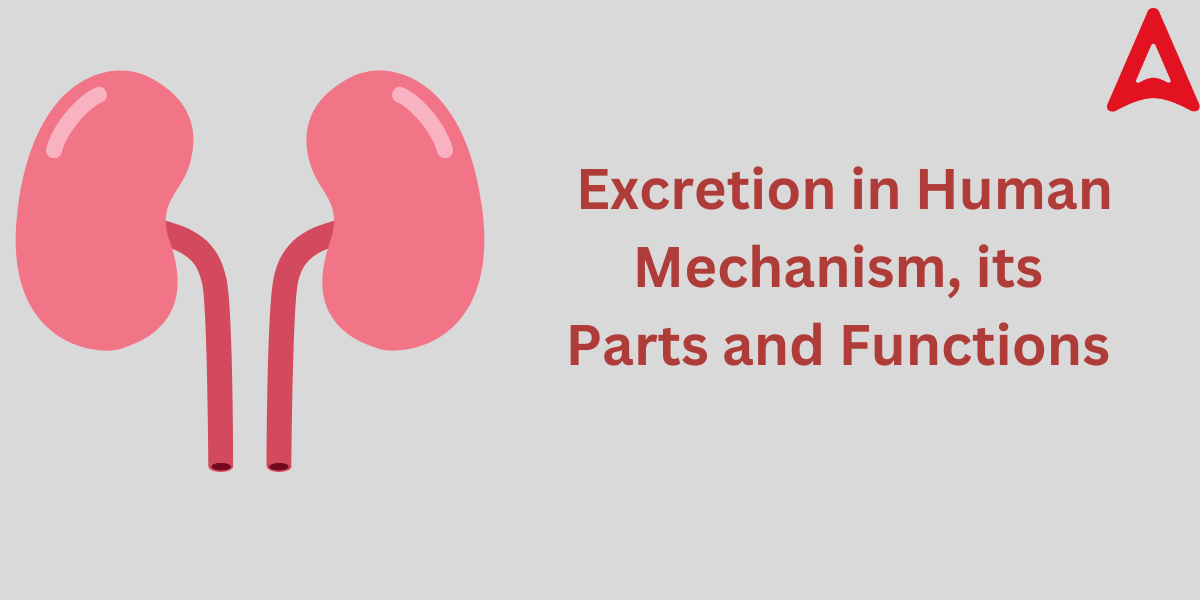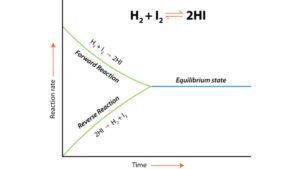Excretion in Humans: Every living organism is dependent on a few fundamental life processes. One of the sorts of life processes is the excretory system. Excretion aids in the elimination of any metabolic waste created by any reaction in the body. Different organisms excrete in different ways. Excretion is also straightforward for basic organisms, and it happens either through diffusion or the expulsion of gases and water. However, The Process of Excretion in Humans is the most complex and advanced carried out by a system of organs made up of numerous organs, which is known as the Human Excretory system. In this article, we are going to learn about the Process of Excretion in Humans, different parts of the Human Excretory system. with their functions.
What is Excretion?
Excretion is a crucial biological activity that happens in each living organism starting from simple organisms (Unicellular) to complex multicellular organisms, such as Humans, plants, and animals. Excretion is the process of removing waste materials, toxins, and surplus materials from an organism’s body, including carbon dioxide, urea, and extra salts. These waste products are created as a result of numerous metabolic processes that take place naturally within the body. Excretion aids in preserving a healthy physiological balance and prevents the buildup of toxic compounds that could be hazardous to the organism’s well-being.
Excretion in Humans
Excretion is the process of removing hazardous wastes from an organism’s body. Whatever we eat generates waste inside our bodies. Many gases and other waste products are created inside an organism’s body as a result of cellular respiration. We all get our nutrients from various sources, which are then digested and processed in our bodies. Following metabolic responses, the body begins to separate helpful and harmful compounds stored in cells. They must be removed appropriately and on a regular basis. They can be poisonous to the human body and can be harmful if they are not removed.
Human Excretory system
The human excretory system is a dedicated system of organs that eliminate waste products from the human body. Our bodies majority generate a lot of urea and carbon dioxide. There are various organs in the body that eliminate waste among them are the kidney, lungs, skin, and eyes.. The process of breathing produces carbon dioxide, while the degradation of unneeded proteins in the liver produces urea. These are the lungs and the kidneys. Our lungs expel carbon dioxide, and our kidneys excrete urea. As a result, the kidney is the primary excretory organ of the human body. Urea is excreted from the body as a liquid by the kidneys through the act of urination, whereas solid wastes are evacuated by the intestines.
Human Excretory System Diagram
Check the diagram below, which depicts the many elements of the human excretory system.

Excretory System Organs
The excretory system in humans is comprised of several organs, including two kidneys, two urinary ureters, a bladder, and a urethra. All of these components work together to ensure proper waste disposal. Organs of the human excretory system include:
- A pair of kidneys
- A pair of ureters
- A urinary bladder
- A urethra
Excretion in Human beings System
)Organs in Human Excretory System play a specialized role to ensure the proper disposal of wasteThe kidneys filter blood to eliminate waste and excess substances, resulting in urine, which is subsequently carried to the bladder and evacuated from the body via the urethra. Let us examine the components of the excretory system and their functions.
Kidney
Human kidney structure can be viewed as two reddish bean-shaped organs in people. On either side of the spine, the kidneys are located exactly beneath the ribcage.A kidney’s usual size is 10-12 cm, its breadth is 5-7 cm, and its weight is 120-170g. the kidneys are made of various parts such as
Capsule: The kidneys have a tough outer coating. This is referred to as the Capsule. The Capsule is divided further into an outer renal cortex and an inner renal medulla.
Hilum: The hilum spreads inside the kidney into a funnel-shaped region known as the renal pelvis, which contains projections known as calyces.
Medullary pyramids: Medullary pyramids project into the calyces and divide the medulla. The cortex extends as renal columns known as Columns of Bertini between the medullary pyramids.
Nephrons: The Kidney’s functional unit is the nephron. The kidney is made up of millions of smaller units or nephrons that are responsible for the reabsorption, secretion, and filtration of waste products within the kidneys.

Function of Kidney
The kidneys are an important part of the human excretory system. Everyone is born with two kidneys. Kidneys serve a crucial function in sorting beneficial substances from hazardous compounds by re-absorption. Each kidney contains millions of small structures known as nephrons, which are in charge of the filtering process. Our kidneys are constantly pumped by blood. The renal artery, also known as the kidney artery, transports blood to the kidneys. Blood contains both beneficial and harmful components Capillaries, a type of blood artery found in the kidneys, aid in the filtering of blood and waste elements.
The renal vein or kidney vein transports the cleaned blood away from the kidneys. As a result, the kidneys extract the harmful compound urea, other waste salts, and excess water from the blood and excrete them as a yellowish liquid known as urine.
Ureters
The ureters are a thin tube-like structure consisting of tiny tissues that exits the kidney at a particular site known as the Renal Pelvis. In the human body, there are two ureters. The ureters are muscular tubes around 25-30 cm long that are responsible for transporting urine, a waste product generated in the kidneys, to the urinary bladder. Peristaltic contractions are used by these muscular tubes to force urine down from the kidneys to the urinary bladder until it is ready to be expelled from the body through the urethra.
Bladder
The urinary bladder is a hollow, muscular sac-like structure found in the pelvic region. Its principal role is to hold urine produced by the kidneys until the time comes for the body to remove it. The process of micturition, or the act of urinating, empty the urine bladder.
The muscular wall of the bladder can expand and contract to accommodate various quantities of pee. When the bladder is full, nerve signals cause the sensation of needing to urinate, and urine is evacuated from the body through the urethra upon voluntary relaxation of the bladder’s muscles.
Urethra
The urethra is the ultimate pathway for pee removal from the body, emerging from the urinary bladder. The urethra’s primary function is to allow urine to exit the bladder and be expelled outside. This is a lengthy tube that opens almost to the prostate gland and aids in the removal of urine produced by the kidney. The urethra contains a Sphincter muscle that helps to protect the urethral opening. It serves as the primary channel for sperm and urine in males.
Excretory system of human process
Excretion is the process through which all metabolic wastes are eliminated from the organism. Excretion in humans occurs in a series of procedures that include various parts of the body and internal organs.
- Renal arteries aid in the passage of blood into the kidneys. Blood is filtered in a structure called nephrons within each kidney. Every nephron is made up mostly of a Glomerulus and a Bowman’s Capsule. During filtration, blood molecules such as glucose, amino acids, salts, water, urea, and others enter Bowman’s capsule and subsequently enter the nephron tubule.
- The filtrate is reabsorbed into the bloodstream after passing through a succession of renal tubules, where important components such as glucose, amino acids, and water are selectively reabsorbed. This prevents these vital chemicals from being lost in the urine.
- Water and solute are reabsorbed when the filtrate travels through the renal tubules and the Loop of Henle, concentrating the urine and helping to conserve water in the body.
- The collecting duct, which leads to the renal pelvis, collects the concentrated urine. Urine flows from the renal pelvis through the ureter to the urinary bladder for temporary storage.
- Nerve signals cause the need to urinate when the bladder is full. When the kidney contracts, urine is evacuated from the body through the urethra.
Kidney Failure
Renal failure, often known as kidney failure, occurs when the kidneys are unable to adequately carry out their vital functions due to factors like accidents, infections, and insufficient blood flow to the kidneys.. Urea and other waste products can build up in the blood when the kidneys completely stop functioning. Even the body’s water content is not controlled.
In this situation when the kidneys are not functioning properly. The best option is kidney transplantation, a surgical procedure used to remove the diseased kidney and transplant a matched kidney from a healthy person. If this is not practicable, a process known as dialysis is used to keep the patient regularly connected to a kidney machine. Artificial kidneys are used in dialysis to filter the blood of the patient
Dialysis
When a person’s kidneys are unable to sufficiently clean their blood by removing the waste product urea from it, a medical technique called dialysis is used. Dialysis plays a critical role in supporting people with renal failure by removing toxic compounds from the body and preserving electrolyte balance.

Blood from an arm artery is forced into the dialyzer of a dialysis machine during the dialysis procedure. The majority of the wastes like urea present in the patient’s blood pass through the selectively permeable membrane cellulose tubes into the dialyzing solution as the patient’s blood flows through the dialyzing solution. The patient’s arm vein is pumped with the cleaned blood once more.









 Chemical Equilibrium NEET Notes, Check I...
Chemical Equilibrium NEET Notes, Check I...
 BSEB Bihar Board Dummy Admit Card 10th 2...
BSEB Bihar Board Dummy Admit Card 10th 2...
 Biology Investigatory Project Class 12- ...
Biology Investigatory Project Class 12- ...












